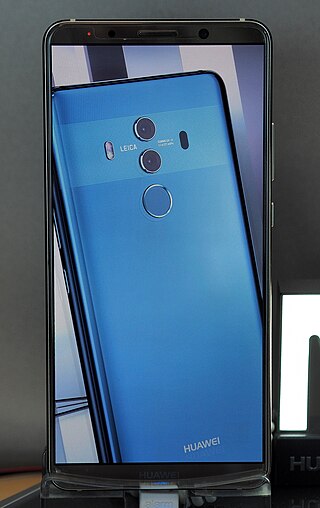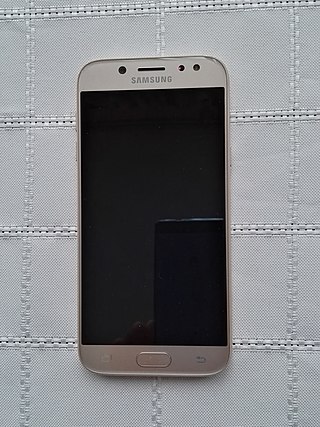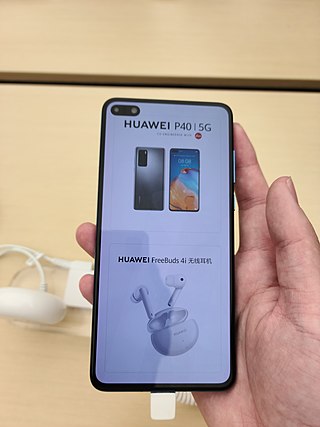Related Research Articles

Nexus 6P is an Android smartphone developed and marketed by Google and manufactured by Huawei. It succeeded the Nexus 6 as the flagship device of the Nexus line of Android devices by Google and was the final Nexus before Google switched to the Pixel lineup. Officially unveiled on 29 September 2015 along with the Nexus 5X at the Google Nexus 2015 press event held in San Francisco, it was made available for pre-order on the same day in United States, United Kingdom, Ireland, and Japan.

The Honor 8 is a smartphone made by Huawei under their Honor sub-brand. It is a successor of the Huawei Honor 7 within the Huawei Honor series.
The Huawei Nova and Huawei Nova Plus are mid-range smartphones manufactured by Huawei. They were announced and released at the Internationale Funkausstellung Berlin (IFA) on Sept. 1, 2016.

The Huawei G8 is an upper mid-range Android smartphone designed and produced by the company Huawei. It was released on 2 September 2015.

The Huawei P10 is an Android phablet smartphone manufactured by Huawei. Announced at Mobile World Congress 2017 on 26 February 2017, the P10 is the successor to the Huawei P9 and was succeeded by the Huawei P20 in 2018.

The Honor 9 is a smartphone made by Huawei under their Honor sub-brand. It is a successor of the Huawei Honor 8 within the Honor N series.

The Huawei Mate 10, Huawei Mate 10 Pro and Huawei Mate 10 Lite are Android smartphones designed and marketed by Huawei as part of the Huawei Mate series. There is also a Mate 10 Porsche design, which has 256 GB of storage but is otherwise identical to the Mate 10 Pro. They were first released on 16 October 2017. Versus the predecessor Mate 9, the Mate 10 pro flagship phone has a faster processor with an integrated neural processing unit, a slightly larger OLED screen (6.0") with a taller 18:9 aspect ratio, a significantly longer battery life and a glass back construction. Chinese and international models are available in dual SIM configuration. It comes with Android 8 and a newer version of Huawei's EMUI interface. All Mate 10 models are unlocked and GSM only. Huawei phones, including the Mate series, are not sold or financed through U.S. carriers due to pressure from U.S. intelligence agencies, though they are available from independent and online retailers.

Samsung Galaxy J5 2017 is an Android-based smartphone produced, released and marketed by Samsung Electronics. It was unveiled and released in July 2017 along with the Samsung Galaxy J3 (2017). It has an advanced 64-bit class system on a chip (SoC) backed by 2 GB or 3 GB Of LPDDR3 RAM. It packs a Non-removable 3000 mAh battery. The Galaxy J5 (2017) is the successor to the Samsung Galaxy J5 (2016).

Huawei P20 and Huawei P20 Pro are Android smartphones manufactured by Huawei. Unveiled 27 March 2018, they succeed the Huawei P10 in the company's P series line.

The Samsung Galaxy J6 is an Android smartphone developed by the Korean manufacturer Samsung Electronics. Announced and released on May 22, 2018 along with the Samsung Galaxy J4 and the Samsung Galaxy J8, the J6 is a mid-range model smartphone and a successor to the Samsung Galaxy J5 (2017).
The OnePlus 6T is an Android-based smartphone from OnePlus. It was announced on October 29, 2018, before being released on November 6. The launch was originally scheduled for October 30, but was rescheduled to avoid coinciding with Apple Inc.'s on the same day.

Huawei Mate 20 is a line of Android phablets produced by Huawei, which collectively succeed the Mate 10 as part of the Huawei Mate series. The flagship models, the Mate 20 and Mate 20 Pro, were unveiled on 20 July 2018 at a press conference in London.

The Samsung Galaxy A7 (2018) is a higher midrange Android smartphone produced by Samsung Electronics as part of the Samsung Galaxy A series. It was announced on 20 September 2018 as the successor of Samsung Galaxy A7 (2017).

The Huawei Mate X is an Android-based high end foldable smartphone produced by Huawei. It was unveiled at MWC 2019 on 25 February 2019 and was originally scheduled to launch in June 2019, but the launch was pushed back to allow for extensive testing in light of the failures reported by users of a similar product, the Galaxy Fold from Samsung. The Mate X launched in China only in November 2019. Huawei announced the Mate Xs on 24 February 2020 as a hardware revision of the original Mate X; it was released in "global markets" outside China in March 2020. The device features a more durable display, improved hinge function and a redesigned cooling system, as well as the newer Kirin 990 5G SoC and Android 10 with EMUI 10.

Huawei Mate 30 is a line of Android-based phablets manufactured by Huawei as part of its Huawei Mate series, and the successor to the Mate 20. The Mate 30 comprises the Mate 30/5G, Mate 30 Pro/5G, and Mate 30 RS Porsche Design, which were unveiled on 19 September 2019 in Munich, Germany.

Huawei P40 is a line of high-end Android-based smartphones manufactured by Huawei. Unveiled on 26 March 2020, they succeed the Huawei P30 in the company's P series line.

The Huawei P50 and P50 Pro are HarmonyOS-based high-end smartphones manufactured by Huawei. Unveiled on 21 July 2021, they succeed the Huawei P40 in the P series. In March 2023 Huawei released their successor Huawei P60 Series phones in China, and in May 2023 it released the Huawei P60 Pro in Europe.
Huawei Y6p is an Android smartphone manufactured by Huawei. Unveiled on 6 May 2020, they succeed the Huawei Y6s in the company's Y series line.
References
- 1 2 3 4 5 6 "Huawei Introduces the HUAWEI Mate 9". Huawei. 3 November 2016. Retrieved 3 November 2016.
- 1 2 3 4 "Huawei Mate 9 is a dual-camera bruiser". CNET. 3 November 2016. Retrieved 3 November 2016.
- 1 2 3 4 5 6 "Huawei Mate 9 review: Hands-on with Huawei's latest smartphone, offering impressive internals, an improved dual-camera setup and a refreshed UI". TechAdvisor. 3 November 2016. Retrieved 3 November 2016.
- 1 2 "Huawei's Mate 9 is what high-end smartphone dreams are made of". Digital Trends. 3 November 2016. Retrieved 3 November 2016.
- ↑ "Huawei Mate 9 features Fingerprints sensor". Planet Biometrics. 4 November 2016. Retrieved 4 November 2016.
- 1 2 "Huawei Mate 9 specifications". Huawei. Retrieved 3 November 2016.
- 1 2 "Huawei Mate 9". NDTV. Retrieved 3 November 2016.
- ↑ "Huawei Mate 9 Connectivity". Huawei. Archived from the original on 6 November 2016. Retrieved 3 November 2016.
- ↑ "HUAWEI Mate 9规格参数". Huawei. Archived from the original on 21 May 2017. Retrieved 14 November 2016.
- ↑ "PORSCHE DESIGN HUAWEI Mate 9 specifications". Huawei. Archived from the original on 4 May 2017. Retrieved 3 November 2016.
- ↑ "Huawei's Mate 9 Becomes the First Alexa Phone". 6 January 2017.
- ↑ "Imint's Vidhance video stabilization in Huawei Mate 9". Aktietorget. 23 January 2017. Archived from the original on 25 August 2017. Retrieved 25 August 2017.
- ↑ TEAM AA. "Android 8.0 Oreo update tracker: December 14, 2018". Android Authority. Retrieved 15 December 2018.
- ↑ "Huawei Mate 9 Review: The Big-Screen Phone for Android Lovers". Tom's Guide. 10 November 2016. Retrieved 11 November 2016.
- ↑ Shaan Haider, "Huawei Mate 9 : Detailed Hands-on Review, Features and Specs ", Geeky Stuffs, May, 2017
